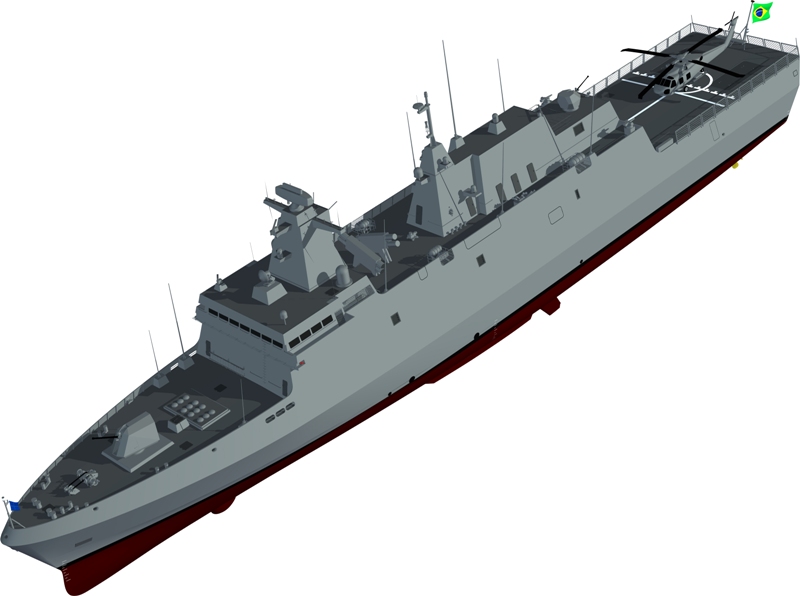
SHAH ALAM: Meko A100 corvette. As we were busy with LIMA 19, Brazil announced in late March that it had chosen a German/Brazilian consortium as the preferred bidder to build four corvettes for its navy. The consortium Águas Azuis Consortium – comprising ThyssenKrupp Marine Systems, Embraer Defense & Security and Atech – will set up a new company to start the process of building the four new Tamandaré-class corvettes.
So what this got to do with Malaysia then? The design for the four corvettes is based on the Meko A100 class from ThyssenKrupp. Yes, its a variant of RMN own Kedah class.
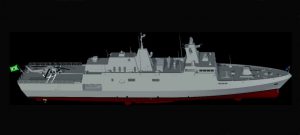
A CGI of the future Tamandre class corvette.
The programme is also likely to involve the transfer of technology (ToT) in the naval engineering for military shipbuilding, combat and platform management systems.
Oceana shipyard in Itajaí, Brazil, will be responsible for building the vessels and acting as ToT receiver related to the project.
The combat management system (CMS) and integrated platform management system (IPMS) will be supplied by Atech in partnership with ThyssenKrupp’s subsidiary ATLAS ELEKTRONIK and L3 MAPPS.
Embraer Defense & Security’s role in the project will be to integrate sensors and weaponry into the combat system.
The consortium’s winning bid is based on the concept of the MEKO-class design for the corvettes.
The design is claimed to deliver acquisition, maintenance, and modernisation cost savings as it enables local integration and transfer of technology.
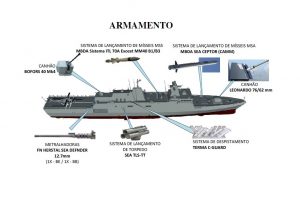
It is interesting to see that ThyssenKrupp had managed to sell the same design some 20 years after it had done the same with Malaysia. Unfortunately, due to malfeasance with PSC Sdn Bhd, we are left with the design but without any new ships.
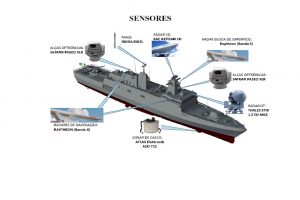
It will be also interesting to see what will happen to the current Kedah class. Based on the conversations I had with the industry during LIMA 19, its not a pretty one.
— Malaysian Defence
If you like this post, buy me an espresso. Paypal Payment

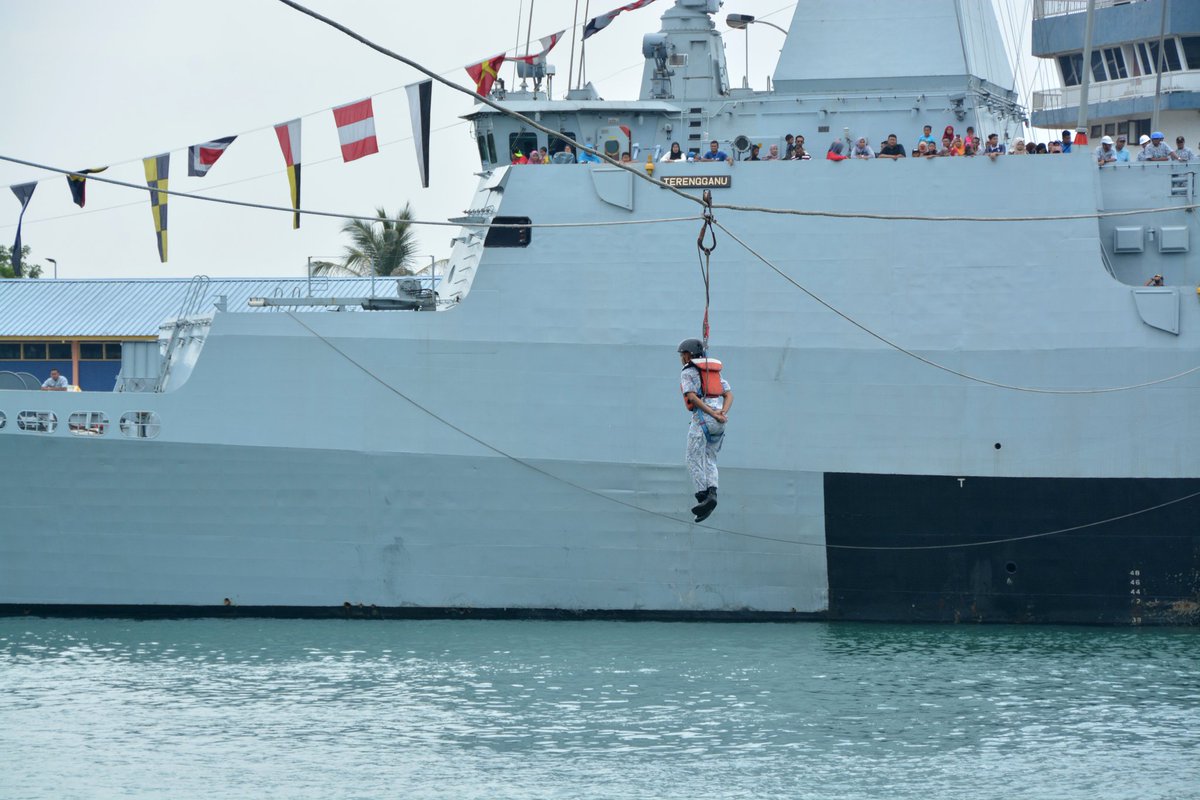
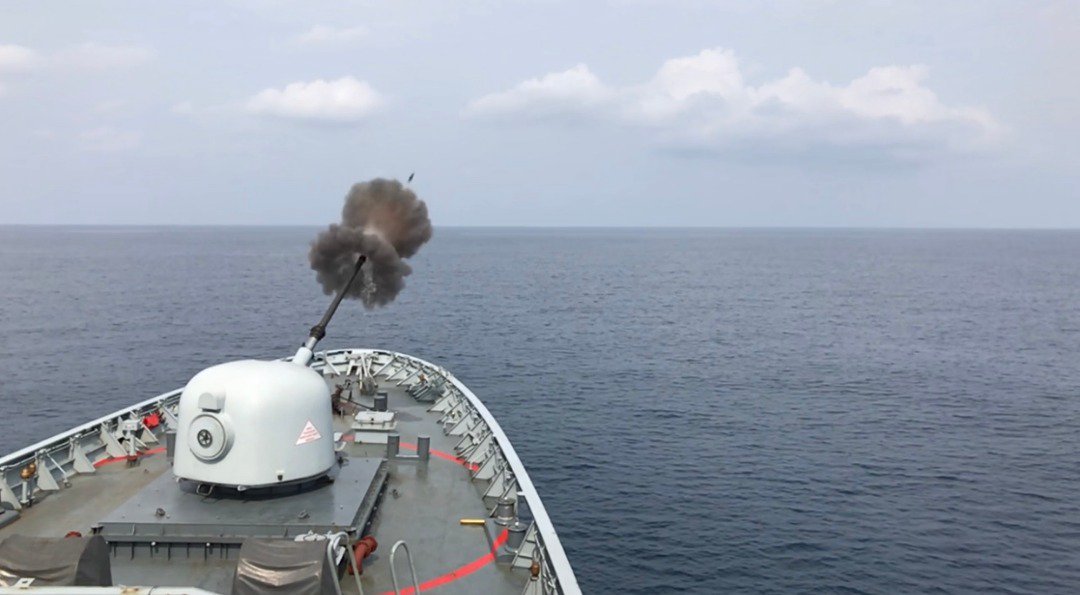

Yes, i have commented on this before
https://www.malaysiandefence.com/mica-deal-kived/#comment-366461
It is basically:
The same variant of enlarged meko a100 that lost to the Gowind for the SGPV LCS competition. The ships will measure 107.2 meters in length and will displace 3,455 tons (our gowinds 111m long and 3,100 tons displacement). The design is still without an exhaust stack, something that is an issue with TLDM.
The price of each of them is USD400 million. (Our meko a100 cost USD300 million, while our Gowinds USD460 million)
It would be a general purpose corvette, so there is no towed array sonar, unlike our gowinds.
As for the armament, guns are 76mm up front, 40mm bofors on top of the hangar (our kedahs has 30mm on top of the hangar), exocet AShM, CAMM anti air missiles and internal torpedo launcher like our Gowinds.
As for our kedah class ships, spending more money to upgrade the ship means less money for something more capable like the Gowinds. In our circumstance, the best way forward for the kedah class IMO is to pass them to MMEA. It would then not be a “warship” anymore, and any actions of the ship against civilian ships etc. would be a policing, not naval action. IMO TLDM should get out of the OPV business altogether, freeing the budget to aquire more frigates and more submarines.
https://www.malaysiandefence.com/another-look-rmn-15-to-5/
So meaning the 15-to-5 plan is going to be a bust? Sigh…
Kudos to you for your continued persistence.on reporting on malaysian defence matters when its always SNAFU
Get out of the OPV business?why? Are we too good? Even the aussie and brits.and dutch are in the OPV business, so why not us? The budget is still the budget from the same pool so grab what you could.
@ shahrudin esa
I did not say us as in Malaysia. What I said is that for TLDM to get out of OPV business. That means leaving the OPV business to MMEA. What I did not agree is for TLDM to get more Kedah-class OPVs, or any OPVs for that matter. Peacetime patrolling is a task of MMEA, as we have MMEA in the 1st place.
MMEA is getting OPVs such as the Damen OPV 1800 for just USD56 million each. Which is in my book better value than the USD300 million Kedah class.
https://www.malaysiandefence.com/wp-content/uploads/2017/10/OPV_1800.jpg
Another ship that would be great for MMEA would be the Indian Coast Guard, larsen & toubro bulit Vikram-class OPV. Each ship just cost USD32 million and it is actually even bigger than our Kedah-class OPV!
http://diplomacybeyond.com/articles/wp-content/uploads/2018/04/ICGS-Vikram.jpg
https://www.iastoppers.com/wp-content/uploads/2017/10/OPV-Vikram-iastoppers.jpg
@ …
The problem is that currently APMM is vastly underfunded for its stated job description.
Even the TLDM, with far more funds and modern vessels available have admitted they are currently overstretched in patrolling Malaysia’s maritime territories.
Yet the APMM is supposed to takeover the job from the TLDM with far, far less funding and 30-40 year old cast-off ships.
@ Military madness
They (TLDM) are overstretched because they buy gold plated ships to do mundane taskings. IMO MMEA has avoided this, and even managed to buy 3 OPVs from the approved budget to buy just 2. More of my answers here in my posting
https://www.malaysiandefence.com/apmm-plans/
I understand your point. However turning over the Kedah OPVs will leave RMN depleted. Lets be realistic, theres no money for some time and even the navies not the coast guards of Australia, NZ, Dutch finds border policing as part of the navy area of responsibility. Why not us? After all, theoretically the Kedah is uogradeable ” under built but not fitted ” for concept. Anyway MMEA policing is adequate for 30mm guns leaving the 76mm Kedahs over gun. The cost …well thats history hopefully MACC and other balancing institution will get their independence before this PM goes. Remembet in WW2 its the Flower class merchantile standard corvettes that win the battle of Atlantic
@ shahrudin esa
As i said again and again, because we have a coast guard! Sigh, this is also why we should have a defence white paper, so something like this would be clear to everyone.
There is no issue of depletion, as the ships will still be operational albeit now under MMEA. TLDM will be getting Gowind frigates soon too.
So why we should use MMEA more for peacetime patrolling?
South China Sea. China and vietnam uses mostly coast guard ships to patrol its contested area. As of right now, vietnam coast guard is even bigger than its own navy. Why? As I said, coast guard activities are considered as civilian policing action, not a military action. Diplomatically that is a huge difference in using a navy or a coast guard ship. That is why most of chinese ships parked in malaysian EEZ is a coast guard ship. Right now, any actions of a malaysian naval warship against a chinese coast guard ship would be seen as a military agression towards the chinese coast guard ship. If we have a coast guard ship to take action against the chinese coast guard ship for example, actions against the chinese coast guard ship would be seen as a policing action.
TLDM should of course still do patrols, but not using and having ships build specifically for that like the Kedah-class. In 15 to 5, they wanted 12 more Kedah class ships, which is IMO a big waste of resources. Resources IMO can be better used for buying more submarines for example. A coast guard specific OPV like the damen OPV 1800 can be bought for like just 20% of the original cost of the Kedah-class, and would do the same mission.
12 more Kedah-class batch 2 ships would probably buy 40-50 more coast guard OPVs like the Vikram-class. Is buying more Kedah-class ships a prudent use of money? That is another reason why it is better for the coast guard to shoulder the OPV tasks, because they can have more cost effective ships to do the missions.
Just for your info, average cost of ships
Kedah class – USD300 million
Keris class LMS – USD60 million
Kedah class batch 2 target cost – USD150 million
MMEA Damen OPV 1800 – USD56 million
Vikram class OPV – USD32 million
Gowind – USD460 million
Arrowhead 140 – USD350 million
Scorpene SSK – USD500 million
@MilitaryMadness
All of our Forces are underfunded and overstretched (except for the Police me thinks). It depends on each of them to make full use of whatever budget they can haggle.
Some managed to get more because they were able to lay out a clearly defined, long term viable plan for their Force (ie TLDM 15 to 5 Plan). Some others (ie CAP55) are just wish list. It is quite sad the conciever of the TLDM plan, Laksamana Kamarulzaman Badaruddin, had retired instead being made Head of the Armed Forces. He could have brought more vision to the Forces and instituted long term planning with SMART goals onto the respective Forces.
Why I want TLDM to get out of the OPV business?
Because I want TLDM to have more fully armed Frigates and Submarines!
From my alternative 15 to 5 plan, using the same budget
” Anyway in my opinion this alternative plan would be able to save money for the government in the short-term, while giving a better capability in the long term compared to the original 15 to 5 plan. Passing most of the OPV business to APMM does not really mean that the maritime security would be compromised, but actually enhanced by letting APMM to get more of the cost-effective Damen OPVs (instead of TLDM’s expensive Meko 100 based Kedah class OPV). Additional funds freed would give the navy budget for ASW helicopters, which is not even in the original plans, more submarines and bigger Frigates. With a total force of 9 ASW Frigate, 4 GP Frigate, 6 Submarines, 4 MRSS, 9 LMS-A and 17 LMS-B (plus 2 training ships KD Gagah Samudra, KD Teguh Samudra and 1 training/OPV ship KD Hang Tuah), the TLDM would shape to be a formidable naval force in the South East Asian region by 2040.
This alternative plan could still be called 15 to 5 as:
1. Gowind
2. Scorpenes
3. LMS
4. MRSS
5. Arrowhead 140 ”
https://www.malaysiandefence.com/another-look-rmn-15-to-5/
@ joe
Ah, SMART goals. Something sorely lacking in most plans (except the excellent TLDM 15 to 5)
SMART Goal
1. Specific. What will the goal accomplish? How and why will it be accomplished?
2. Measurable. How will you measure whether or not the goal has been reached?
3. Achievable. Is it possible? Have others done it successfully? Do we have the necessary knowledge, skills, abilities, and resources to accomplish the goal? Will meeting the goal challenge them without defeating them? Achievable goals motivate people. Impossible goals demotivate them.
4. Results-focused. What is the reason, purpose, or benefit of accomplishing the goal? What is the result (not activities leading up to the result) of the goal?
5. Time-bound. What is the established completion date and does that completion date create a practical sense of urgency?
@…
I doubt the APMM would want to operate something as complex and advanced as the Kedah-class OPVs as part of their fleet. Simply put, a lot of their job scope does not need such high-tech gear.
APMM already has maintenance issues with the older equipment it is currently saddled with, they don’t need the extra hassle of maintaining such complex warships for their use.
This is where the APMM leadership is showing sone common sense in their recent acquisitions.
While a few large OPVs are useful for some coast guard duties, the majority of their job scope (sea interdiction, anti piracy patrols, maritime law enforcement) only requires smaller, faster patrol boats to perform.
Heard that KDN will form a task force to deal with maritime intrusion. With this new task force and APMM there is no need for RMN to have patrol ships. RMN just need submarine, frigate/corvette, and MRSS.
@ military madness
Compared to current ships, there is nothing that is complex and advanced on the Kedah-Class OPV. In MMEA Pelan Perancangan Strategik Maritim Malaysia 2040 (PPSMM 2040), some of the known targets to be had by 2040:
– 9,414 personnel
– C4ISR and surveillance of the whole of malaysian waters and EEZ
– 20 large patrol ships
– 96 medium patrol ships
– 228 boats less than 20m in length (95 interceptors, 133 RHIB)
– 15 Helicopters
– 12 Fixed wing aircraft
This is the current Large Sized Patrol Boats (>60m) in APMM service:
7501 KM Langkawi (Musytari)
7502 KM Banggi (Marikh)
9203 KM Pekan (PL-02 Erimo)
8704 KM Arau (PL-01 oki)
They are currently building 3x DAMEN OPV 1800 ships, which is as big as the Kedah-class OPVs.
Why MMEA (and not TLDM) need 20 large OPVs?
This is why
http://www.warontherocks.com/2018/04/china-welcomes-its-newest-armed-force-the-coast-guard/
http://www.amti.csis.org/tracking-chinas-coast-guard-off-borneo/
http://www.theborneopost.com/2015/09/27/presence-of-china-coast-guard-ship-at-luconia-shoals-spooks-local-fishermen/
@ romeo
That is a good direction to take IMO. Improvements towards the better. Hope that this will be reflected in the Defence White Paper.
The correct link for above
http://amti.csis.org/tracking-chinas-coast-guard-off-borneo/
BTW another article on “white hulls” aka Coast Guard.
” One way Beijing has wielded its power to achieve its ends in the South China Sea has been through the China Coast Guard. Rather than enforcing sovereignty with its navy, China has placed a less intimidating face on these activities by using its “white hulls.” Coast guards are often seen as less escalatory, typically have less armament than their naval counterparts, and provide “a less militaristic face of state power.” Beijing has effectively utilized these forces to counter claims that it is militarizing the South China Sea as well as to harass its neighbors, as it did when the Coast Guard chased Filipino fishermen from the Spratly Islands in April 2017, and entered Japanese territorial seas last month near the Senkaku Islands. ”
https://warontherocks.com/2018/02/white-hull-approach-taming-dragon-using-coast-guard-counter-china/
Off topic
Argentina getting used south korean frigates as OPVs
https://ukdefencejournal.org.uk/argentina-to-recieve-hand-frigate-from-south-korea/
Something we can do also, getting used ships for stopgap measures for MMEA. Those ulsans, can be sailed without using the gas turbines for economy, probably used for 10-15 years before the Kedah-class passed to MMEA and more newer OPVs (more damen OPV 1800 and such) bought for MMEA.
https://en.m.wikipedia.org/wiki/Ulsan-class_frigate
Hi all, should Malaysia buy LMS and other ships from overseas or build locally? In view of the need for barter trade with palm oil, buying from overseas is the default option. After the initial purchase cost is only about 30% of the total lifecycle cost of ownership with the remaining 70% being sustenance cost which can be outsourced to local shipyards.
Hi All, is it necessary to set up a dedicated and integrated central agency for the entire Malaysian Armed Forces, MMEA and RMP, which would act as a statutory board by an act of parliament for procurement and program management of defence assets to ensure CAT, optimum total cost of ownership and maximum availability and readiness of the assets over their lifespans? This has been done by other countries such as DSTA for Singapore, USOD (AT&L) for USA and CONSTIND for China.
@ jo
It depends…
Yes it is good to buy from overseas if we can pay them with palm oil.
But what kind of ships? For what task?
Say you have a budget of USD60 million for 1 LMS ship.
When you look around,
The korean gumsokduri-class ship costs less than USD50 million per ship.
http://ipfs.busy.org/ipfs/QmSyVyqsBwAXYErbyZt8BE7jV4odymc9a1ArsKaPbHxz7j
As is the azmat class ship built in china for pakistan but is more heavily armed
http://www.navyrecognition.com/index.php/news/year-2011-news/september-2011-navy-naval-air-force-news/95-launching-ceremony-in-china-for-the-first-fast-attack-missile-vessel-azmat-for-pakistan-navy-2409111.html
If you just want a patrol ship, lighty armed, South Africa got Damen to build this for about USD35 million.
https://www.businessinsider.co.za/3-new-military-patrol-vessels-are-being-built-in-cape-town-2019-2
So it really depends on lots of different factors. But the most important thing is, did we get the most bang for the buck?
Central agency for defence procurements? Theoretically good. But is it practical? ie will those doing the decisions follow the findings? Or will politics and diplomatical considerations be a top priority?
So, how to get the most bang for the buck? IOW, how to ge thet or quantify ROI for buying the ship, eg at USD 68 mil per LMS? In the 15 to 5 document, the ROI is terms of increased availability and readiness above 85%.
@…In case of the central agency materializes, the govt or ministries, armed forces, maritime and police will be the customers to the agency. The creation of the agency is meant to stamp out political interference and any potential corruptions in major public expenditures after defence policy development by the clients. Diplomatic considerations can be part of the procurement criteria. Can we say this is part of the institutional reform programme?
@ jo
Throwing out all those numbers, i feel that you are one of those that is in the game.
I am just a civilian, no high education, no nothing.
Just to put out a number…
If the target is for increased availability and readiness above 85%.
– if a ship that costs just USD35 million can put out the above target, would it be a better buy compared to the USD60 million LMS?
– what is the OPEX for each ship to get that 85% readiness target?
– what mission can or must the ship perform?
Put out all the measurable targets, like readiness, minimum mission functions, etc. and compare apple to apple.
I have written in length of my opinions on the LMS, the 1st one about 3 years ago.
https://www.malaysiandefence.com/another-perspective-lms/
My take on the LMS concept:
– Must be strictly be defined by its operating area. Malacca Straits and ESSCOM would be its main operating area, preferably under the radar coverage of coastal surveillance radars.
– To excel in asymmetric warfare with non-state actors, terrorists and pirates. To be able to engage and fight a swarm-type attack (something like 12-20 fast boats) comfortably. Not to fight submarines or large frigates. Not to be seen as a lower cost LCS/SGPV/Gowind frigate but an optimized ship concept for asymmetric warfare in littoral and near shore areas.
– Seaward Defence, to prevent non-state actors to reach Malaysian shores (preventing another Lahad Datu type of mass landings)
– Able to do sea denial (blockade, ship raiding, minelaying) and also anti-sea denial (MCM, striking fast boats and enemy FACs)
– To have specialized VBSS teams and RHIB for rapid ship boardings.
– Manned areas armored to take hits from small caliber arms (AK-47 and similar)
– High end versions capable of self defence against AShM, aircafts.
– Low end versions to be able to do multiple tasks such as logistics, HADR, SAR, Dive support, troop ferrying (subtype) and Hydrography (subtype)
Another one 2 years ago
https://www.malaysiandefence.com/another-perspective-lms-2/
Off topic
Recent altercation between Vietnam Fisheries Resources Surveillance and Indonesian Navy.
http://wow.tribunnews.com/2019/04/28/kronologi-kapal-dinas-vietnam-sengaja-tabrak-kapal-perang-indonesia-di-laut-natuna
This is a resent as the one i posted earlier is not visible
@ jo
I am just a civilian, not someone in the game.
Anyway just to put out a number…
So the target is for increased availability and readiness above 85%.
– if a ship that costs just USD35 million can meet or fulfil the above target, would it be a better buy compared to the USD60 million LMS?
– what is the OPEX for each ship to get that 85% readiness target?
– what mission can or must the ship perform?
Put out all the measurable targets, like readiness, minimum mission functions, etc. and compare apple to apple.
I have written in length of my opinions on the LMS, the 1st one about 3 years ago.
https://www.malaysiandefence.com/another-perspective-lms/
My take on the LMS concept (just my opinion, shaped by a hope that the LMS is not just a normal patrol boat):
– Must be strictly be defined by its operating area. Malacca Straits and ESSCOM would be its main operating area, preferably under the radar coverage of coastal surveillance radars.
– To excel in asymmetric warfare with non-state actors, terrorists and pirates. To be able to engage and fight a swarm-type attack (something like 12-20 fast boats) comfortably. Not to fight submarines or large frigates. Not to be seen as a lower cost LCS/SGPV/Gowind frigate but an optimized ship concept for asymmetric warfare in littoral and near shore areas.
– Seaward Defence, to prevent non-state actors to reach Malaysian shores (preventing another Lahad Datu type of mass landings)
– Able to do sea denial (blockade, ship raiding, minelaying) and also anti-sea denial (MCM, striking fast boats and enemy FACs)
– To have specialized VBSS teams and RHIB for rapid ship boardings.
– Manned areas armored to take hits from small caliber arms (AK-47 and similar)
– High end versions capable of self defence against AShM, aircafts.
– Low end versions to be able to do multiple tasks such as logistics, HADR, SAR, Dive support, troop ferrying (subtype) and Hydrography (subtype)
Another one 2 years ago
https://www.malaysiandefence.com/another-perspective-lms-2/
@jo
When we have political consideration of ToT, current bilateral relations and now palm oil bartering,how can an agency for defence procurement be impartial or objective in meeting their clients (ie TDM, TUDM, TLDM, other enforcement agencies) needs?
Much like how TUDM wanted Super Hornets but due to our strained relations with US at that time and Russia offer of bartering, TUDM got MKMs instead. How can another agency help in this situation? They have no say and no power to decide, and their clients still likely don’t get what they wanted unless it meets the politicians requirements. This is just adding more headcount to an already bloated civil service and for meaningless purpose.
@joe, the agency will consider the 3 issues you mentioned during its procurement process. The defence policy is et by MoD, armed forces, police and coast guard.
@joe, the central agency can be set up by adapting TSA under MITI now to become a full-pledged procurement and program delivery statutory body. So no increased in staffing to the already bloated civil service. The agency section through program managers will be responsible and answerable for defence acquisition projects from cradle to grave. These program managers are civilian, not uniformed men so they can stay long to take care of their programs over their full lifespan. TSA is already in charge of ToT. The agency will decide based on bid selection criteria which will include ToT, bilateral relations and palm oil barter trade, etc. Google for DSTA of Singapore which is successful in building LMV, submarine sold to Singapore only and on the way to get F-35 from US.
Google for DSTA of Singapore which is successful in building LMV, submarine sold to Singapore only and on the way to get F-35 from US.
Hi All, Is it okay if I assume that the sustenance cost of a navy ship will be 70% of the total cost of ownership and 30% be the initial purchase price?